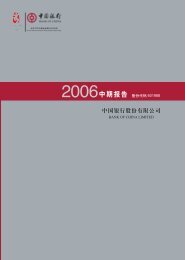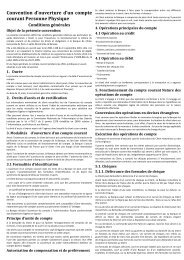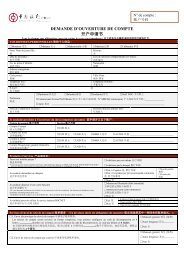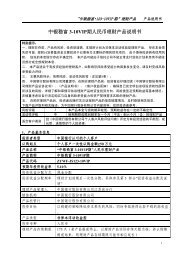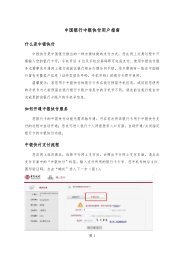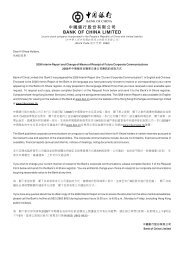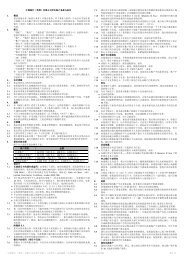2006 Interim Reportï¼A Share.pdf - ä¸å½é¶è¡
2006 Interim Reportï¼A Share.pdf - ä¸å½é¶è¡
2006 Interim Reportï¼A Share.pdf - ä¸å½é¶è¡
You also want an ePaper? Increase the reach of your titles
YUMPU automatically turns print PDFs into web optimized ePapers that Google loves.
Domestic Operations are required to place an RMB statutory deposit reserve, a foreign currency statutory deposit<br />
reserve and a fiscal deposit with the PBOC. At 30 June <strong>2006</strong>, the required reserve ratio for customer deposits<br />
denominated in RMB was 7.5% (2005: 7.5%); the required reserve ratio for customer deposits denominated in foreign<br />
currencies is 3% (2005: 3%). The fiscal deposit of Domestic Operations is comprised of funds from government<br />
agencies, and proceeds of bonds issued on behalf of the MOF. The foreign currency deposit reserve and fiscal deposits<br />
placed with the PBOC are non-interest bearing.<br />
2. Trading and other debt securities at fair value through profit or loss<br />
Trading<br />
30 June <strong>2006</strong> 31 December 2005<br />
Government bonds 27,761 19,116<br />
Public sector and quasi government bonds 3,088 2,095<br />
Financial institution bonds 23,600 30,599<br />
Corporate bonds 3,794 4,179<br />
Sub-total 58,243 55,989<br />
Other debt securities at fair value through profit or loss<br />
(designated at initial recognition)<br />
Government bonds 9,267 10,704<br />
Public sector and quasi government bonds 11,218 12,974<br />
Financial institution bonds 26,667 19,979<br />
Corporate bonds 5,207 7,625<br />
Sub-total 52,359 51,282<br />
Total 110,602 107,271<br />
Included in other debt securities at fair value through profit or loss are debt securities with respect to which the Group<br />
has established economic hedges using derivative instruments. Gains and losses arising on the derivatives are intended<br />
to substantially offset the gains and losses arising on these securities, which might have otherwise been<br />
classified as "available-for-sale" or "held-to-maturity" securities.<br />
3. Derivative financial instruments<br />
The Group enters into the following foreign exchange rate or interest rate related derivative financial instruments for<br />
trading and risk management purposes:<br />
The contractual/notional amount and fair values of derivative instruments held by the Group are set out in the<br />
following table. The contractual/notional amounts of certain types of financial instruments provide a basis for<br />
comparison with fair value instruments recognised on the balance sheet but do not necessarily indicate the amounts<br />
of future cash flows involved or the current fair value of the instruments and, therefore, do not indicate the Group's<br />
exposure to credit or market risks. The derivative instruments become favourable assets or unfavourable (liabilities)<br />
as a result of fluctuations in market exchange rate, interest rates or equity/commodity prices relative to their terms.<br />
The aggregate fair values of derivative financial assets and liabilities can fluctuate significantly from time to time.<br />
The fair values of derivatives that are not quoted in active markets are determined by using valuation techniques.<br />
Valuation techniques used include discounted cash flows analysis and models. To the extent practical, models use<br />
only observable data, such as interest rate and foreign exchange rates, however areas such as credit risk (both own<br />
and counterparty's), volatilities and correlations require management to make estimates. Changes in such observable<br />
data and assumptions about these factors could affect reported fair value of financial instruments.<br />
79



